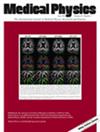Megavoltage intrafraction monitoring and position uncertainty in gimbaled markerless dynamic tumor tracking treatment of lung tumors
Abstract
Background
The clinical realization of markerless dynamic tumor tracking (MLDTT) has prompted a new paradigm shift to intrafraction imaging-based quality assurance (QA). During MLDTT treatment using a gimbaled accelerator, the megavoltage (MV) imager serves as an independent system to leverage real-time intrafraction monitoring. Soft-tissue feature tracking has shown promise for tumor localization in confined MV projections, but studies demonstrating its application in clinical MLDTT treatments are scarse.
Purpose
To validate MV image-based dense soft-tissue feature tracking for intrafraction position monitoring of lung tumors during MLDTT stereotactic body radiotherapy (SBRT), and report on the resolved geometric uncertainty.
Methods
Ten non-small cell lung cancer (NSCLC) patients underwent MLDTT-SBRT using a commercial gimbal-based system. During treatment, beam's-eye-view (BEV) projection images were captured at ∼3 frames s−1 (fps) using the electronic portal imaging device (EPID). MV sequences were streamed to a research workstation and processed off-line using a purpose-built algorithm, the soft-tissue feature tracker (SoFT). Both the tumor and dynamic field aperture position were automatically extracted in the pan and tilt directions of the gimbaled x-ray head, corresponding to the in-plane lateral and longitudinal direction of the imager, and compared to ground truth manual tracking. The success, percentage of fields producing an output, and performance of MV tracking under the presence/absence of anatomy-related obstruction and multi-leaf collimator (MLC) occlusion were quantified, including three-dimensional conformal (3DCRT) and step-and-shoot intensity modulated radiotherapy (IMRT) deliveries. In addition, the geometric uncertainty of MLDTT treatment was estimated as the difference between field aperture and target center position in the BEV. The standard deviation of systematic (Σ) and random (σ) errors were determined.
Results
MV tracking was successful for 89.7% of (unmodulated) 3DCRT fields, as well as 82.4% of (modulated) control points (CPs) and subfields (SFs) for IMRT and field-in-field 3DCRT deliveries. The MV tracking accuracy was dependent on the traversed anatomy, tumor visibility, and occlusion by the MLC. The mean MV tracking accuracy was 1.2 mm (pan) and 1.4 mm (tilt), and a resultant 2D accuracy of 1.8 mm. The MV tracking performance within 2 mm was observed in 92.1% (pan) and 86.6% (tilt), respectively. The mean aperture-target positional uncertainty smaller than 3 mm/5 mm was observed in 94.4/97.9% (pan) and 89.6/96.7% (tilt) of the time. The group Σ and σ were 0.5 mm/0.8 mm (pan), and 0.7 mm/1.2 mm (tilt), compared to 0.3 mm/0.5 mm (pan), and 0.6 mm/0.9 mm (tilt) based on the manual ground truth.
Conclusion
MV imaging coupled with the soft-tissue feature tracker algorithm constitutes a valuable non-invasive method for independent intrafraction surveillance. Tracking multiple features has shown the potential to improve position estimation, notwithstanding obstruction, and occlusion challenges, facilitating the quantification of the geometric uncertainty of MLDTT treatment.


 求助内容:
求助内容: 应助结果提醒方式:
应助结果提醒方式:


